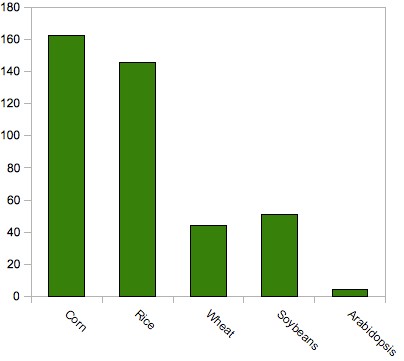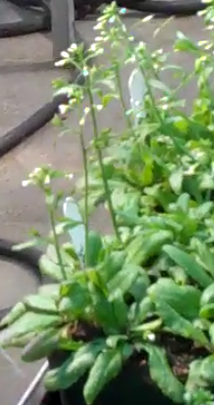Arabidopsis thaliana is a plant which though its small size, possession of the first sequenced plant genome (released in 2000 four years before the complete human genome), and short generation time* has become a common sight in plant biology labs around the world. From an applied standpoint, the main problem with Arabidopsis research is that, like any model organizism, sometimes biologists discover things that are broadly applicable to the plant world (including important crop species, from apricots to zuccinnis) and sometimes their discoveries turn out to be specific to arabidopsis and some of its close relatives.
Since Arabidopsis is probably now the most studied plant on the planet, could we cut out the middle-man and simply grow fields of arabidopsis? You’re about to become one of the few people who knows the answer to that question.
Yesterday I was hanging out with a friend who works in an Arabidopsis lab and got a demonstration of how to havest Arabidopsis seeds.** Harvesting seeds from a two square-foot flat of arabidopsis plants gave him close to seven milliliters of seeds.*** Milliliters per square foot, that’s yield! Admittedly in unconventional units but that’s easy enough to fix:
- There are 43,560 square feet in an acre: 152.5 liters of arabidopsis seeds per acre (152,460 milliters)
- One bushel = ~35.24 liters: ~4.33 bushels of arabidopsis seeds per acre.
To put that in context, I’ve prepared this helpful figure:

Yield of arabidopsis and several other species. Yield measured in bushels per acre. Yield numbers for crop species are US averages.
The more you know…
Caveats:
- This data was from the Colombia ecotype of Arabidopsis. As far as I know, no one has tried breeding arabidopsis for increased yield per acre. If they did, seeds per acre could easily increase.
- The chart assumes one harvest per year. Arabidopsis grows quickly enough (that short generation time again) that many regions might be able to harvest multiple crops per year.
- I’ve been told Arabidopsis leaves are sometimes served in salads by geeky plant scientists. I don’t have any data on Arabidopsis yield per acre as a source of leafy greens.
- This analysis doesn’t take into account the difficulties of harvesting an acre of Arabidopsis plants, which are many.
*The time it takes to go from a planted seed to a plant producing seeds ready to be planted.
**Also controlled pollinating of Arabidopsis flowers. But more on that later.
***Yes, we’re measuring seeds in milliliters. Arabidopsis seeds are TINY, you don’t want to count them individually. I once knew a girl who got a summer internship in an arabidopsis lab, where she spent the majority of her summer counting out groups of exactly 1,000 arabidopsis seeds, just to see if a mutation had an effect on the average weight of seeds. … as far as I know she hasn’t been interested in plant biology since.

LOL @ your figure! I’m going to print that one out and hang it in my cubicle for all my coworkers to enjoy.
Comment by Amy — March 10, 2010 @ 5:18 pm
Thank you!
Comment by James — March 10, 2010 @ 10:57 pm
And if you need another anecdote about how tiny arabidopsis seeds are, after a year of plating T1 seeds for a project in college, I had to get glasses to correct minor nearsightedness. Some how I’m still in plant bio, but I haven’t had to handle At seeds in any sort of volume for nearly six years (and my eyesight hasn’t deteriorated any further!).
Comment by Amy — March 10, 2010 @ 5:22 pm
A friend of mine had an “Arabidopsis Chex” box as a gag slide in his defense. With something like “Greatly enlarged to show texture” or some such nonsense. He was tired of all the crop plant folks giving him grief.
Comment by Ron — March 11, 2010 @ 10:33 am